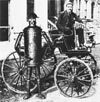
 Here we go again. Another memoirist has been unmasked as a phony. This time it's Nasdijj, celebrated Native-American author of autobiographical works such as The Blood Runs Like A River Through My Dreams and The Boy and the Dog Are Sleeping. Turns out he ain't Native American, unless by Native American one means white anglo-saxon protestant. His real identity seems to be that of Tim Barrus, who grew up in a middle-class community in Lansing, Michigan. As Barrus, he was a pioneer of gay "leather" erotica, before the gay community got tired of his antics and he disappeared for a few years, only to resurface as Nasdijj. The Native American community has had its doubts about him for quite a while, since he never seemed to have a firm grasp on the nuances of Navajo culture. But he's been fully unmasked by Matthew Fleischer in an article in this week's LA Weekly.
Here we go again. Another memoirist has been unmasked as a phony. This time it's Nasdijj, celebrated Native-American author of autobiographical works such as The Blood Runs Like A River Through My Dreams and The Boy and the Dog Are Sleeping. Turns out he ain't Native American, unless by Native American one means white anglo-saxon protestant. His real identity seems to be that of Tim Barrus, who grew up in a middle-class community in Lansing, Michigan. As Barrus, he was a pioneer of gay "leather" erotica, before the gay community got tired of his antics and he disappeared for a few years, only to resurface as Nasdijj. The Native American community has had its doubts about him for quite a while, since he never seemed to have a firm grasp on the nuances of Navajo culture. But he's been fully unmasked by Matthew Fleischer in an article in this week's LA Weekly. Two weeks ago a lot of people were linking to a story about books bound in human skin that can be found in many libraries, including the rare book libraries at Brown and Harvard. This is, apparently, quite true. Often the books are old medical works, with the skin coming from patients or paupers whose bodies were bought for research. The most gruesome book, owned by the Boston Athenaeum, is an 1837 copy of the memoirs of the highwayman George Walton, bound in his own skin.
Two weeks ago a lot of people were linking to a story about books bound in human skin that can be found in many libraries, including the rare book libraries at Brown and Harvard. This is, apparently, quite true. Often the books are old medical works, with the skin coming from patients or paupers whose bodies were bought for research. The most gruesome book, owned by the Boston Athenaeum, is an 1837 copy of the memoirs of the highwayman George Walton, bound in his own skin. Linkydinky.com is offering a product called the magicSHELF. Kathy Johnston emailed me to ask: "Is this for real? I can't tell how it works." Unfortunately, I don't yet have a definitive answer. The magicSHELF has stumped me.
Linkydinky.com is offering a product called the magicSHELF. Kathy Johnston emailed me to ask: "Is this for real? I can't tell how it works." Unfortunately, I don't yet have a definitive answer. The magicSHELF has stumped me.  |
 |
 |
 The million little biographical lies of James Frey have been getting all the attention in the press this week, but as the Devon Western Morning News reminds us, this month marks the 50th anniversary of the publication of a memoir whose lies were far greater: The Third Eye by T. Lobsang Rampa (aka the Plumber from Plympton). Rampa claimed to have grown up in Tibet (born into a wealthy Tibetan family), to have studied in Lhasa to become a lama, and then to have undergone a mysterious operation to open up the "third eye" in the middle of his forehead. This operation supposedly gave him psychic powers. But in reality, Rampa wasn't a Tibetan monk. He was actually Cyril Henry Hoskins, son of a plumber from Plympton, England. He hadn't even been to Tibet. As the Western Morning News puts it:
The million little biographical lies of James Frey have been getting all the attention in the press this week, but as the Devon Western Morning News reminds us, this month marks the 50th anniversary of the publication of a memoir whose lies were far greater: The Third Eye by T. Lobsang Rampa (aka the Plumber from Plympton). Rampa claimed to have grown up in Tibet (born into a wealthy Tibetan family), to have studied in Lhasa to become a lama, and then to have undergone a mysterious operation to open up the "third eye" in the middle of his forehead. This operation supposedly gave him psychic powers. But in reality, Rampa wasn't a Tibetan monk. He was actually Cyril Henry Hoskins, son of a plumber from Plympton, England. He hadn't even been to Tibet. As the Western Morning News puts it: Savannah Knoop |
 J.T. LeRoy |
 In my Gallery of Hoax Websites (which I created about four years ago, and which has since been superceded by the Hoax Websites category of the weblog), I list the website of Boilerplate, the Victorian Era Robot. The site details the history of a robot named Boilerplate who was supposedly created during the 19th century in order to replace humans in combat. I admit that the site had me going for a while, and that I only realized it was a hoax when I tried to check the bibliographic references, none of which referred to real books. It seems I wasn't the only one to be taken in by Boilerplate. The New York Times reports that comedian Chris Elliott, believing Boilerplate was a nineteenth-hoax (not a modern one), incorporated the robot into his historical novel, The Shroud of the Thwacker. Only when the creator of Boilerplate threatened to sue him for copyright infringement did Elliott realize his mistake. If only Elliott had checked my site, he would have known better.
In my Gallery of Hoax Websites (which I created about four years ago, and which has since been superceded by the Hoax Websites category of the weblog), I list the website of Boilerplate, the Victorian Era Robot. The site details the history of a robot named Boilerplate who was supposedly created during the 19th century in order to replace humans in combat. I admit that the site had me going for a while, and that I only realized it was a hoax when I tried to check the bibliographic references, none of which referred to real books. It seems I wasn't the only one to be taken in by Boilerplate. The New York Times reports that comedian Chris Elliott, believing Boilerplate was a nineteenth-hoax (not a modern one), incorporated the robot into his historical novel, The Shroud of the Thwacker. Only when the creator of Boilerplate threatened to sue him for copyright infringement did Elliott realize his mistake. If only Elliott had checked my site, he would have known better.
 The National Portrait Gallery has reported that the Grafton portrait, long thought to depict Shakespeare as a young man, doesn't depict him at all. They don't know who the guy in the painting is. The portrait apparently served as the inspiration for the portrayal of Shakespeare in the movie Shakespeare in Love.
The National Portrait Gallery has reported that the Grafton portrait, long thought to depict Shakespeare as a young man, doesn't depict him at all. They don't know who the guy in the painting is. The portrait apparently served as the inspiration for the portrayal of Shakespeare in the movie Shakespeare in Love. J.T. LeRoy is either a) an extremely shy young man who, at the age of 13, while living a life of abuse and prostitution on the streets, met a psychologist who encouraged him to write down his experiences, which he did, thereby propelling him to literary stardom (now in his mid-twenties, LeRoy has three books, one of which has been made into a movie); or b) a woman in her late-thirties called Laura Albert who, for the past eleven years, has crafted an elaborate hoax to make people believe that LeRoy is a real person.
J.T. LeRoy is either a) an extremely shy young man who, at the age of 13, while living a life of abuse and prostitution on the streets, met a psychologist who encouraged him to write down his experiences, which he did, thereby propelling him to literary stardom (now in his mid-twenties, LeRoy has three books, one of which has been made into a movie); or b) a woman in her late-thirties called Laura Albert who, for the past eleven years, has crafted an elaborate hoax to make people believe that LeRoy is a real person.